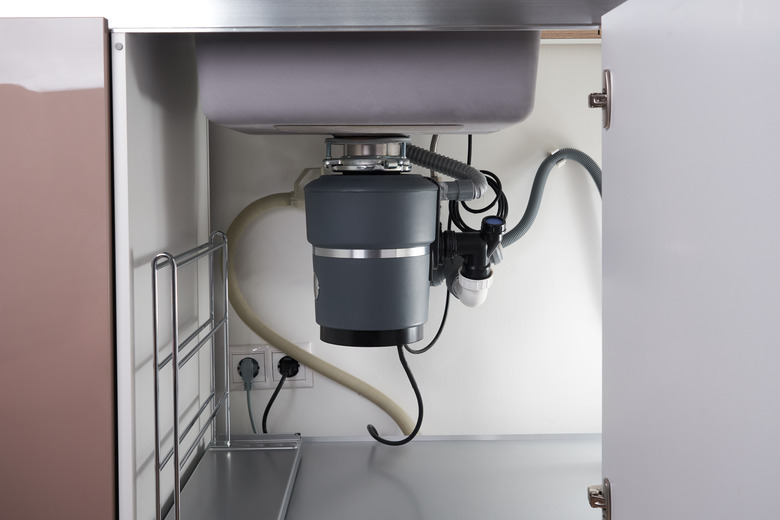Making Garbage Disposal Connections To PVC Drainpipes
We may receive a commission on purchases made from links.
A garbage disposal is part of the drain system for the sink under which it's installed, so it needs an outlet. This is typically on the side of the unit, and the part that connects the outlet to the drain is a 1 1/2-inch black plastic or metal fitting. The one most often supplied with a new garbage disposal is a 90-degree elbow that faces down, and it's usually preinstalled on the unit. Some units have a straight outlet to which you need to attach a slip-joint elbow and a short length of pipe to connect to the trap.
When you're plumbing a single sink with a garbage disposal, the elbow feeds straight into the P-trap. In a double-sink configuration, some plumbers extend the garbage disposal drain all the way to the tailpiece for the second sink, and the tailpiece feeds into a trap that serves both sinks. In that case, you could use either the elbow connector or a straight one, but there's a better way to assemble the drain for a double sink, and it calls for an elbow connector.
A Typical Single-Drain Configuration
A Typical Single-Drain Configuration
You install a garbage disposal by tightening a collar onto a flange connected to the sink drain opening and hooking the disposal unit onto that. There are two ports in the side of the disposal unit, and they must be facing in the direction of the drain. The top port is for connecting a dishwasher, so if you don't have one, you can ignore this port. There's a factory-installed plug in there that should remain where it is.
The drain connects to the lower elbow fitting. If it isn't preinstalled, you screw it to the side of the unit to make a watertight connection. If it's a 90-degree connector, you simply fit the mouth of the P-trap around it and tighten the compression nut on the trap to hold it in place. If it's a straight connector, you first need to install a slip-joint elbow and a short length of pipe and then you insert the pipe in the trap opening. You feed the horizontal arm on the other side of the trap to the waste pipe, which is usually in the wall.
Making a Double-Drain Connection
Making a Double-Drain Connection
If you have a double sink, you have two options: You can use a single trap to service both of them, or you can provide each sink with its own trap. In the first setup, the trap is attached to the tailpiece of the sink without the disposal (the tailpiece is a section of straight pipe that extends down from the sink), and the disposal connects to a tee installed on the tailpiece. You need a straight length of pipe to connect to the tailpiece, and the plumbing part for this is called a waste arm extension. It has an elbow on one end that you connect to the elbow fitting on the disposal unit.
This is a common arrangement, but it doesn't work very well because it creates a bottleneck at the tee opening. A better arrangement has each sink emptying into its own trap and the horizontal arms of both traps feeding into a wye fitting (a drainage fitting shaped like the letter "Y") that outlets into the main waste pipe.
How to Connect a Dishwasher
How to Connect a Dishwasher
If you have a dishwasher, you'll need to use the upper port on the garbage disposal, and since it's plugged, you have to remove the plug. To do this, insert a screwdriver into the opening, tap it with a hammer, and the plug will fall into the disposal basket where you can retrieve it using tongs.
You attach the flexible hose that runs from the dishwasher to this drain port. You can usually simply fit this hose onto the stubout and secure it with a pipe clamp. Sometimes, you first need to install a connector to provide enough clearance for the hose. This is a rubber fitting that clamps onto the stubout and to which you clamp the dishwasher hose.
